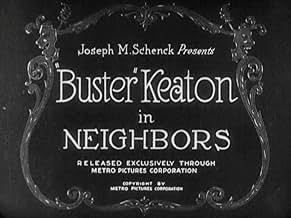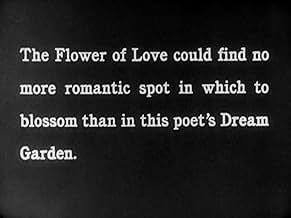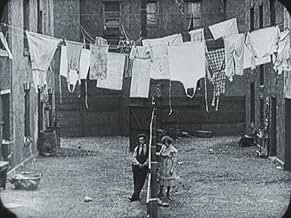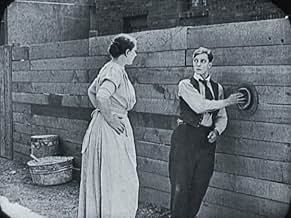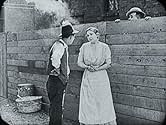VALUTAZIONE IMDb
7,5/10
4908
LA TUA VALUTAZIONE
Una giovane coppia che vive uno di fronte all'altro in un condominio fa tutto ciò che possono pur di stare insieme, cercando di superare i dissidi tra le loro famiglie.Una giovane coppia che vive uno di fronte all'altro in un condominio fa tutto ciò che possono pur di stare insieme, cercando di superare i dissidi tra le loro famiglie.Una giovane coppia che vive uno di fronte all'altro in un condominio fa tutto ciò che possono pur di stare insieme, cercando di superare i dissidi tra le loro famiglie.
- Regia
- Sceneggiatura
- Star
Edward F. Cline
- The Cop
- (non citato nei titoli originali)
Jack Duffy
- The Judge
- (non citato nei titoli originali)
The Flying Escalantes
- Themselves
- (non citato nei titoli originali)
Virginia Fox
- The Girl
- (non citato nei titoli originali)
Joe Keaton
- His Father
- (non citato nei titoli originali)
Joe Roberts
- Her Father
- (non citato nei titoli originali)
Recensioni in evidenza
This Buster Keaton short has some outstanding and breathtaking stunts. You have to see it to believe it.
Buster is in love with his neighbour. They send notes through a hole in the fence. Their respective fathers disapprove of the romance.
Buster is determined to marry his girl even though he goes through a series of mishaps involving both families and the police.
The plot itself is frothy and silly. Buster constantly gets detained by a policeman and then escapes. At one point he is blacked up when escorted by a policeman and then runs away for the policeman to arrest a black man who walks past.
Given that this short was made in 1920. This is still the early days of cinema. Some of the physical acrobatic stuff Buster does is impressive, including three men standing on top of each other which happens at the end. A few times I had to rewind it and watch it again.
Buster is in love with his neighbour. They send notes through a hole in the fence. Their respective fathers disapprove of the romance.
Buster is determined to marry his girl even though he goes through a series of mishaps involving both families and the police.
The plot itself is frothy and silly. Buster constantly gets detained by a policeman and then escapes. At one point he is blacked up when escorted by a policeman and then runs away for the policeman to arrest a black man who walks past.
Given that this short was made in 1920. This is still the early days of cinema. Some of the physical acrobatic stuff Buster does is impressive, including three men standing on top of each other which happens at the end. A few times I had to rewind it and watch it again.
A BUSTER KEATON Silent Short.
Buster's romance with the pretty girl across the back fence leads to great trouble with the NEIGHBORS.
Keaton's superb athletic abilities are highlighted in this very funny little film. The backs of the tenement houses were constructed to Buster's exact physical specifications, giving him hand & foot holds precisely where he would need them, allowing him to climb, slide, cling, tumble, etc., culminating in the hilarious three-man high stunts that climax the film. Big Joe Roberts plays the beefy papa of Buster's beloved.
Born into a family of Vaudevillian acrobats, Buster Keaton (1895-1966) mastered physical comedy at a very early age. An association with Fatty Arbuckle led to a series of highly imaginative short subjects and classic, silent feature-length films - all from 1920 to 1928. Writer, director, star & stuntman - Buster could do it all and his intuitive genius gave him almost miraculous knowledge as to the intricacies of film making and of what it took to please an audience. More akin to Fairbanks than Chaplin, Buster's films were full of splendid adventure, exciting derring-do and the most dangerous physical stunts imaginable. His theme of a little man against the world, who triumphs through bravery & ingenuity, dominates his films. Through every calamity & disaster, Buster remained the Great Stone Face, a stoic survivor in a universe gone mad.
In the late 1920's Buster was betrayed by his manager/brother-in-law and his contract was sold to MGM, which proceeded to nearly destroy his career. Teamed initially with Jimmy Durante and eventually allowed small roles in mediocre comedies, Buster was for 35 years consistently given work far beneath his talent. Finally, before lung cancer took him at age 70, he had the satisfaction of knowing that his classic films were being rediscovered. Now, well past his centenary, Buster Keaton is routinely recognized & appreciated as one of cinema's true authentic geniuses. And he knew how to make people laugh...
Buster's romance with the pretty girl across the back fence leads to great trouble with the NEIGHBORS.
Keaton's superb athletic abilities are highlighted in this very funny little film. The backs of the tenement houses were constructed to Buster's exact physical specifications, giving him hand & foot holds precisely where he would need them, allowing him to climb, slide, cling, tumble, etc., culminating in the hilarious three-man high stunts that climax the film. Big Joe Roberts plays the beefy papa of Buster's beloved.
Born into a family of Vaudevillian acrobats, Buster Keaton (1895-1966) mastered physical comedy at a very early age. An association with Fatty Arbuckle led to a series of highly imaginative short subjects and classic, silent feature-length films - all from 1920 to 1928. Writer, director, star & stuntman - Buster could do it all and his intuitive genius gave him almost miraculous knowledge as to the intricacies of film making and of what it took to please an audience. More akin to Fairbanks than Chaplin, Buster's films were full of splendid adventure, exciting derring-do and the most dangerous physical stunts imaginable. His theme of a little man against the world, who triumphs through bravery & ingenuity, dominates his films. Through every calamity & disaster, Buster remained the Great Stone Face, a stoic survivor in a universe gone mad.
In the late 1920's Buster was betrayed by his manager/brother-in-law and his contract was sold to MGM, which proceeded to nearly destroy his career. Teamed initially with Jimmy Durante and eventually allowed small roles in mediocre comedies, Buster was for 35 years consistently given work far beneath his talent. Finally, before lung cancer took him at age 70, he had the satisfaction of knowing that his classic films were being rediscovered. Now, well past his centenary, Buster Keaton is routinely recognized & appreciated as one of cinema's true authentic geniuses. And he knew how to make people laugh...
No, nothing to do with the Aussie soap opera. This "Neighbors"- I keep the original American spelling- is a silent comedy short from 1920. The plot is a comic take on the "Romeo and Juliet" story. Buster Keaton and Virginia Fox play young lovers who live in flats in adjoining buildings but whose families are constantly quarrelling with one another. Both families are, of course, hostile to the young people's relationship, and the film is the story of how Buster and Virginia overcome the obstacles to their love. (I use the names of the actors because we never find out the names of their characters. The cast-list simply refers to "The Boy" and "The Girl").
Modern rom-coms also often deal with how young couples deal with the obstacles to their love, but today such "obstacles" are generally metaphorical- not only parental disapproval but also things like differences in social class or a fear of commitment. This being a silent comedy, however, the obstacles in "Neighbors" can be literal, physical barriers such as a wooden fence separating the two properties and the fact that Virginia's bedroom is on the third floor. Buster has to use his acrobatic skills to overcome these barriers with circus-style stunts involving a trapeze and much balancing on top of ladders.
Films like this were a part of my childhood in the sixties and seventies because they were often shown on British television. I suspect that this was done to provide a nostalgic treat for my grandparents' generation, who would have remembered them from their youth, but they also proved popular with my own generation. My parents were both born in the thirties and, having grown up after the sound revolution, regarded silents as very old-fashioned, so I often ended up watching them with Grandma and Grandpa. I was certainly not alone among my schoolfriends in my enthusiasm for these old films; they were not expressly made as children's films, but there was obviously something about their physical style of humour which appealed to the young.
To the modern adult, this style of humour can seem as unsophisticated as it did to my parents; one of the gags, for example, involves Buster's trousers falling down during the wedding ceremony after his belt breaks. We have to remember, however, that the cinema of the 1910s and early 1920s was, of necessity, experimental. Silent acting, whether in comedy or serious drama, was something new, and film-makers could not rely upon the traditional skills of the theatre, where actors could speak. Pioneers like Keaton, who acted as co-writer and co-director of this film, had to be continually experimenting to find out what worked and what didn't. And in "Neighbors" he does sometimes succeed in making us laugh.
Modern rom-coms also often deal with how young couples deal with the obstacles to their love, but today such "obstacles" are generally metaphorical- not only parental disapproval but also things like differences in social class or a fear of commitment. This being a silent comedy, however, the obstacles in "Neighbors" can be literal, physical barriers such as a wooden fence separating the two properties and the fact that Virginia's bedroom is on the third floor. Buster has to use his acrobatic skills to overcome these barriers with circus-style stunts involving a trapeze and much balancing on top of ladders.
Films like this were a part of my childhood in the sixties and seventies because they were often shown on British television. I suspect that this was done to provide a nostalgic treat for my grandparents' generation, who would have remembered them from their youth, but they also proved popular with my own generation. My parents were both born in the thirties and, having grown up after the sound revolution, regarded silents as very old-fashioned, so I often ended up watching them with Grandma and Grandpa. I was certainly not alone among my schoolfriends in my enthusiasm for these old films; they were not expressly made as children's films, but there was obviously something about their physical style of humour which appealed to the young.
To the modern adult, this style of humour can seem as unsophisticated as it did to my parents; one of the gags, for example, involves Buster's trousers falling down during the wedding ceremony after his belt breaks. We have to remember, however, that the cinema of the 1910s and early 1920s was, of necessity, experimental. Silent acting, whether in comedy or serious drama, was something new, and film-makers could not rely upon the traditional skills of the theatre, where actors could speak. Pioneers like Keaton, who acted as co-writer and co-director of this film, had to be continually experimenting to find out what worked and what didn't. And in "Neighbors" he does sometimes succeed in making us laugh.
Neighbors (1920)
*** (out of 4)
Buster Keaton does the Romeo and Juliet storyline as he falls in love with his neighbor but it'll be hard to get married since the families hate one another. There are plenty of good gags here including the human fly swatter gag and the stuff dealing with Keaton trying to avoid the police. Keaton also delivers one of his best stunts and three people on one another's shoulders try and walk from house to house with Keaton being three stories up.
Available on Kino's The Art of Buster Keaton Collection, which is one of the greatest box sets out there.
*** (out of 4)
Buster Keaton does the Romeo and Juliet storyline as he falls in love with his neighbor but it'll be hard to get married since the families hate one another. There are plenty of good gags here including the human fly swatter gag and the stuff dealing with Keaton trying to avoid the police. Keaton also delivers one of his best stunts and three people on one another's shoulders try and walk from house to house with Keaton being three stories up.
Available on Kino's The Art of Buster Keaton Collection, which is one of the greatest box sets out there.
A viewer who has never seen a Buster Keaton comedy might get the wrong idea of what to expect from this film's introductory title card, which reads: "The Flower of Love Could Find No More Romantic Spot in Which to Blossom Than in This Poet's Dream Garden." We are then shown a grungy courtyard between two tenement buildings divided by a fence, and on opposite sides of the fence we find The Boy (Buster) and The Girl (Virginia Fox), sweetly in love but kept apart by feuding parents. But fear not, for the flowery wording of that introduction is meant in jest: Neighbors is no exercise in Griffith-style sentimentality about poor people. (For one thing, if D.W. Griffith had directed this he'd have called it "Romeo & Juliet of the Slums" or perhaps "Pyramis & Thisbe of Pig Alley.") This isn't a melodrama of life among the lowly, it's Buster in his youthful prime, and it's funny. There's action and comedy galore, and it's interesting to observe that the attitude expressed towards love and marriage is far from sentimental --which is a little surprising, considering that 24 year-old Buster was still a fun-loving bachelor when he made this movie.
In any event, once the situation is established we are treated to a series of fast-moving gag sequences emphasizing the hostile relationship between The Girl's father (played by Buster's frequent screen nemesis Big Joe Roberts) and The Boy's father (played by Buster's own dad Joe Keaton). It is clear that the two fathers hold each other in contempt, and vigorously oppose any closer relationship between their respective families. There's a great example of Keaton's special brand of physical comedy early on when Buster attempts to visit Virginia in her third floor room. When he's caught by her father he promptly flings himself out her window, across a clothesline that leads to his own window across the way, down a banister and back across the clothesline to Virginia's building, right smack into Big Joe. The sequence flashes by in seconds and may leave you blinking in amazement, but before you can catch your breath Buster has been forcibly hung upside down by his feet from the clothesline, hauled back across the courtyard like dirty laundry, and then (accidentally) beaten by his father, who has mistaken his own son for a rug. Moments later, Buster is dumped head-first through a rain barrel into sopping wet mud. And so it goes! Welcome to This Poet's Dream Garden.
Neighbors is a comedy better seen than described. At times it feels like a live-action Warner Brothers cartoon, but instead of Bugs Bunny and Yosemite Sam we're watching actual people perform these stunts. The premise of feuding families is a simple and effective framework for Keaton's terrific set-pieces. (He would return to the family feud motif on a much grander scale in Our Hospitality a few years later.) The rougher slapstick material is briefly held in check as the brawling families are dragged into court, chastised by a judge, and ordered to permit their offspring to wed. But needless to say the ceremony is a disaster, and the action resumes with a wild finale in which Buster and Virginia escape from their families to elope. The best gag sequence is saved for last, as Buster takes part in a three-man balancing act racing through the streets, a bit that required the participation of the Flying Escalantes, a team of acrobats Buster knew from his vaudeville days. Latter day cartoon directors such as Chuck Jones and Tex Avery often gave credit to the influential silent era comedians they'd admired as kids, and the finale of this film must surely have been the sort of thing they were talking about.
While Neighbors may not rank in the very top tier of Keaton's output it's an exhilarating, highly amusing comedy that holds up well today. Besides, Buster's second-echelon efforts are better than most anyone else's masterworks!
In any event, once the situation is established we are treated to a series of fast-moving gag sequences emphasizing the hostile relationship between The Girl's father (played by Buster's frequent screen nemesis Big Joe Roberts) and The Boy's father (played by Buster's own dad Joe Keaton). It is clear that the two fathers hold each other in contempt, and vigorously oppose any closer relationship between their respective families. There's a great example of Keaton's special brand of physical comedy early on when Buster attempts to visit Virginia in her third floor room. When he's caught by her father he promptly flings himself out her window, across a clothesline that leads to his own window across the way, down a banister and back across the clothesline to Virginia's building, right smack into Big Joe. The sequence flashes by in seconds and may leave you blinking in amazement, but before you can catch your breath Buster has been forcibly hung upside down by his feet from the clothesline, hauled back across the courtyard like dirty laundry, and then (accidentally) beaten by his father, who has mistaken his own son for a rug. Moments later, Buster is dumped head-first through a rain barrel into sopping wet mud. And so it goes! Welcome to This Poet's Dream Garden.
Neighbors is a comedy better seen than described. At times it feels like a live-action Warner Brothers cartoon, but instead of Bugs Bunny and Yosemite Sam we're watching actual people perform these stunts. The premise of feuding families is a simple and effective framework for Keaton's terrific set-pieces. (He would return to the family feud motif on a much grander scale in Our Hospitality a few years later.) The rougher slapstick material is briefly held in check as the brawling families are dragged into court, chastised by a judge, and ordered to permit their offspring to wed. But needless to say the ceremony is a disaster, and the action resumes with a wild finale in which Buster and Virginia escape from their families to elope. The best gag sequence is saved for last, as Buster takes part in a three-man balancing act racing through the streets, a bit that required the participation of the Flying Escalantes, a team of acrobats Buster knew from his vaudeville days. Latter day cartoon directors such as Chuck Jones and Tex Avery often gave credit to the influential silent era comedians they'd admired as kids, and the finale of this film must surely have been the sort of thing they were talking about.
While Neighbors may not rank in the very top tier of Keaton's output it's an exhilarating, highly amusing comedy that holds up well today. Besides, Buster's second-echelon efforts are better than most anyone else's masterworks!
Lo sapevi?
- QuizIncluded in "Buster Keaton: The Shorts Collection" blu-ray set, released by Kino.
- Citazioni
His Father: He's my son and I'll break his neck any way I please!
- ConnessioniEdited into The Golden Age of Buster Keaton (1979)
I più visti
Accedi per valutare e creare un elenco di titoli salvati per ottenere consigli personalizzati
Dettagli
- Tempo di esecuzione18 minuti
- Mix di suoni
- Proporzioni
- 1.33 : 1
Contribuisci a questa pagina
Suggerisci una modifica o aggiungi i contenuti mancanti

Divario superiore
By what name was Saltarello e la sua vicina (1920) officially released in Canada in English?
Rispondi
